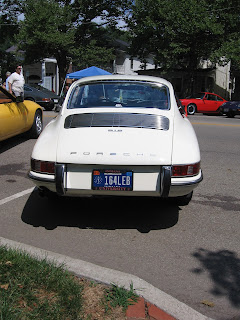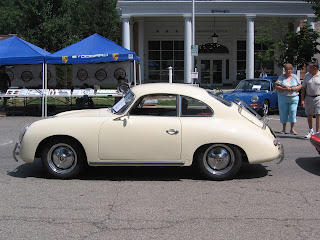What is this thing doing here! Nice eccentric VW, but it perpetuates a historical misconception.
Friend Kirby with his newer acquisition!
Hi folks -- I wan't planning on going to Granville, Ohio on Saturday to P2O, as the site change from Oxford, Ohio disgruntled me a bit and I was simply tired. But I got a call at 7 a.m. from Cliff asking if I had left yet, and him wanting to go. So I slowly woke up, got my car ready to go, and took off to Xenia to pick up cliff. As it turned out, Cliff wanted to drive his 944, so off we went in a non-air conditioned water pumper Porsche.
Starting in Centerville, this trip is not nearly as scenic -- much of the way is typically on I-70 unless you make a new off-the-beaten-path route that is not as direct. It was sort of weird on the road, as we did not see one Porsche until we got to Granville, and for a while I thought this event had been canceled or moved! When we got there, traffic was terrible and parking was worse, as the town had put so many no parking signs one had to park far away if not clever and resourceful. We were the latter, and took in what proved to be a good but hardly great event.
Complaints include no real swap meet or used parts; folks only rarely opened their cars front and rear, so only infrequently could we see engines and boots; some folks friendly, but also a number of pompous owners and trophy wives with relatively new cars. "My dog is bigger than your dog." I depise those non-technical materialists.
Sunday, 29 July 2012
Sunday, 15 July 2012
Review II: Driving America at The Henry Ford
Labeled as the "World's Premier Automotive Exhibition," the Driving Americaexhibit at the Henry Ford comes with very high expectations. With an emphasis on users of the automobile rather than producers, this exhibit does depart from the norm of "place one car after another on the floor with little to guide them and let the viewer decide what, if anything, to learn." The exhibit is far more nuanced than what is found in the majority of automobile museums, and reflective of recent historical scholarship in the history of technology and American social and cultural history.
On several levels it succeeds in teaching the public, young and old, gear head and disinterested wife, about how everyday Americans lives were profoundly changed by this machine that changed the world. By using a number of immersive interactive kiosks, and a well-done short film shown in the Driving America theater, the museum visitor, during one afternoon, has the opportunity to learn about as much as one would be exposed to in a good introductory course on the automobile and American life. Further, it is more than appropriate that this exhibit is at the Henry Ford Museum, since automobility had such significant and important Michigan and Dearborn roots. With an extensive in-house automobile collection that includes numerous rare cars, including a Bugatti Royale and Tucker 48, and a repository of ephemeral materials second to none, there are plenty of artifacts to put on the floor and in display cases that contain excellent explanatory descriptions.
Upon walking into the exhibit, this reviewer's first impressions were striking. The light from several neon signs coupled with colors reflected from the automobiles immediately takes one into a Disney-like world. One section of the exhibit is chronological, and begins with walking shoes, horses, and stage coaches. But then the panels quickly move into turn of the century pioneer automobiles, including as one might predict, Henry Ford's Quadricycle. From that point onwards this section takes us predictably from one decade or era to another, finally ending with plug-in electric cars. Adjacent to this is a section on auto racing, which is a favorite among auto hobbyists and the young. The cars and colors are luscious, and the backdrops are artistically and thematically well done.
To write that Driving America is the end-all of automobile museum efforts, however, would be disingenuous, however. First, the exhibit suffers from a common shortcoming among those who put these car presentations together. Namely, there seems to be this need or urge to put all of one toys out on the table. Consequently, the exhibit ends up being choked with cars placed on every square foot of the floor, overwhelming the scene at the expensive of meaningful learning experiences. To be sure, the most historically significant cars are out there, including the 1924 Chrysler Touring Car and the Essex closed body design of the early 1920s. But some of the cars placed on the wings just clutter things up, and diffuse the main theme that should be the focus of the work. Secondly -- and I know that there is considerable debate on this point -- to isolate the cars behind barriers takes so much away from the potential learning experience. I know these cars are extremely valuable, but at the Audi Museum at Ingolsadt, Germany, for example, one can walk right up to the cars and even touch them -- and some of those cars, including several Rennwagens from the 1930s, are worth just as much as a Tucker 48, if not more.
1896 Ford Quadricycle
1903 curved dash Oldsmobile
1906 Thomas -- for the rich and elite!
1924 Chrysler Touring
A Coffin Nose Cord 812, 1937
Finally, much use is made of the interactive learning kiosks throughout the exhibit, and they can be great learning tools. Yet, I wonder where the "driving" comes into this exhibit. An interactive driving section -- using simulators or some other kind of device like that -- would take a static presentation and make it dynamic. After all, driving in America is about fun, exhilaration, and freedom, and one gets it by doing, not just watching.
Saturday, 14 July 2012
A Review: The Driving America Exhibit at the Henry Ford
One highlight of the exhibit is an a excellent short film on the history of car culture in America.
As you begin (or end) your walk through you can stop and eat at a dinner from the late 1940s!
As you go down a walk way and change levels, this 1955 Chevy looks right at you!
A 1955 Corvette Headlight
Neon signs are used very effectively throughout this exhibit.
The Engine of Henry Ford's famous 999
A Land speed breaking vehcile from the mid-1960s
Ohio George's drag car -- from Dayton, Ohio!
Hi folks -- I just got back from the Henry Ford and wanted to post a few photos. Much more on this exhibit and other photos will shortly follow. My compliments to Bob Casey and his staff for a terrific effort!
As you begin (or end) your walk through you can stop and eat at a dinner from the late 1940s!
As you go down a walk way and change levels, this 1955 Chevy looks right at you!
A 1955 Corvette Headlight
Neon signs are used very effectively throughout this exhibit.
The Engine of Henry Ford's famous 999
A Land speed breaking vehcile from the mid-1960s
Ohio George's drag car -- from Dayton, Ohio!
Hi folks -- I just got back from the Henry Ford and wanted to post a few photos. Much more on this exhibit and other photos will shortly follow. My compliments to Bob Casey and his staff for a terrific effort!
Thursday, 12 July 2012
MGAs Come to Dayton, July 2012: Safety Fast!
What great cars! My first car was a 1959 MGA 1500, so I have a special place in my heart for these vehicles. Until this morning I forgot just how much these cars sound like sewing machines when they start up, or how under powered they really are. And so impractical, but I never quite thought about it when I owned one. No door locks, side curtains, two six volt batteries in series located behind the seats.
But there is nothing like driving one on a balmy evening towards dusk!
Monday, 9 July 2012
Come to Ohio! Bumper Stickers Seen on One Car from the Suburbs!
This afternoon I had to run a quick errand out of the house for my wife. As I left our housing development and was stopped at a red light there was a car in front of me that had three bumper stickers on it. They said:
GOD SAID IT, I BELIEVE IT
MARRIAGE: BETWEEN ADAM AND EVE, NOT ADAM AND STEVE
JOHN BOEHNER -- A MAN FOR ALL SEASONS
Tuesday, 3 July 2012
Chevy Volts Did well in June, 2012 -- How will the Leaf fare?
GM stated today that 1,760 Volts were sold in June, a good number although it will take more than that to reach the 45,000 a year target set earlier that now has been put on a shelf. in part the sales increase may be due to the Volt now being allowed a privileged place on California commuter lanes.
Nissan leaf sales have not done so well in the recent past, although with the ramping up of production in Tennessee as a the result of a low cost $1.4 Billion loan, perhaps the story of the Leaf in the U.S. is only in its beginning chapter.
But, with gas here in Ohio now down to the level of $3.20, will anyone want to buy a Volt or Leaf with so many better cars available for the asking at comparable prices? Our current culture of selfish individualism dictates against that long run environmentally-friendly choice.
Nissan leaf sales have not done so well in the recent past, although with the ramping up of production in Tennessee as a the result of a low cost $1.4 Billion loan, perhaps the story of the Leaf in the U.S. is only in its beginning chapter.
But, with gas here in Ohio now down to the level of $3.20, will anyone want to buy a Volt or Leaf with so many better cars available for the asking at comparable prices? Our current culture of selfish individualism dictates against that long run environmentally-friendly choice.
Automobile Designer Sergio Pininfarina Dies at age 85 --
Some of the most beautiful cars ever to hit the streets came from this man --
Born in Turin, after joining Carrozzeria Pininfarina, he quickly became integral to the company, and during his career oversaw many of the designs (particularly Ferraris) for which the company is famous. In 1961 his family surname was changed from Farina to Pininfarina, to match that of the company, by decree of the Italian president.
In 1965 it was Sergio Pininfarina who personally persuaded Enzo Ferrari to adopt a "mid-engined" engine configuration, with the engine positioned behind the driver but ahead of the rear wheels, for a new line of road cars. The resulting Ferrari Dino Berlinette Speciale was presented at the Paris Motor Show in October, although it would be another two years before the cars were offered for sale.
After his father's death in 1966, Pininfarina became chairman of the company.
Born in Turin, after joining Carrozzeria Pininfarina, he quickly became integral to the company, and during his career oversaw many of the designs (particularly Ferraris) for which the company is famous. In 1961 his family surname was changed from Farina to Pininfarina, to match that of the company, by decree of the Italian president.
In 1965 it was Sergio Pininfarina who personally persuaded Enzo Ferrari to adopt a "mid-engined" engine configuration, with the engine positioned behind the driver but ahead of the rear wheels, for a new line of road cars. The resulting Ferrari Dino Berlinette Speciale was presented at the Paris Motor Show in October, although it would be another two years before the cars were offered for sale.
After his father's death in 1966, Pininfarina became chairman of the company.
The Automobile and the Problem with Generation Y
Generation Y is one important market segment that researchers are focusing on with regards to automobile use and attitudes towards. Of course, one problem is precisely defining what is Generation Y, or the so-called "Echo Boomers?" Born sometime between the late 1970s or early 1980s and the mid-2000s, this group was hit particularly heard by the 2008/9 financial crisis and that fact certainly plays into the question of how they interface with the automobile.
Some 80 million Americans fit in the marketing demographic of individuals between the ages of 16 and 34. Researchers have found they drive less, with a larger than historically normal percentage not possessing a license. In fact 26 % in 2010 do not have a license, an astonishing figure.
And yes, smartphones assist those young people in getting better train and bus connections.
But in fact, sampling where these folks live certainly will skew results and interpretation. Beyond the coasts and large cities, Americans are path dependent on the car -- and thus in Dayton Ohio, every one of my current students has a car. In New York, Philadelphia, LA, Chicago, the percentages would be far less. But remember, America is a big country and the center of it in many important respects is not on the coasts, but in the Heartland. And market researchers need to remember that when releasing information that can be sensationalized for the influential coastal newspapers and media.
Subscribe to:
Comments (Atom)


































